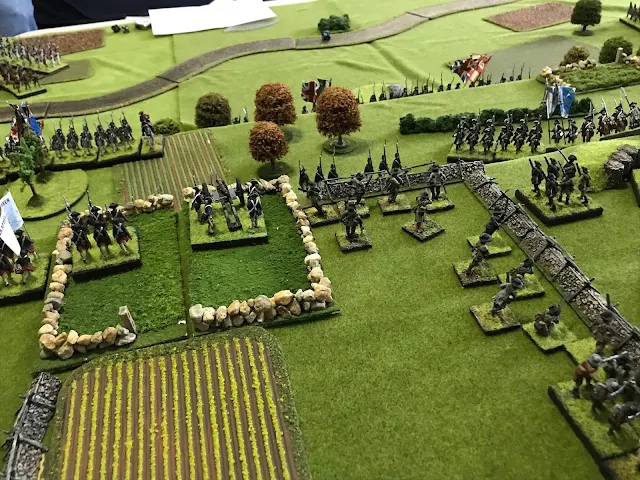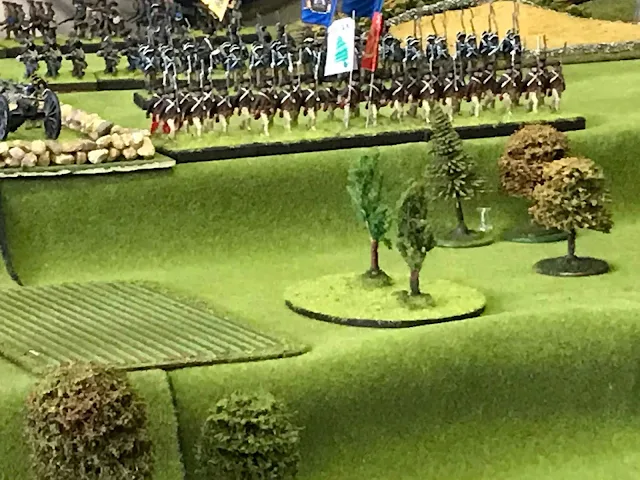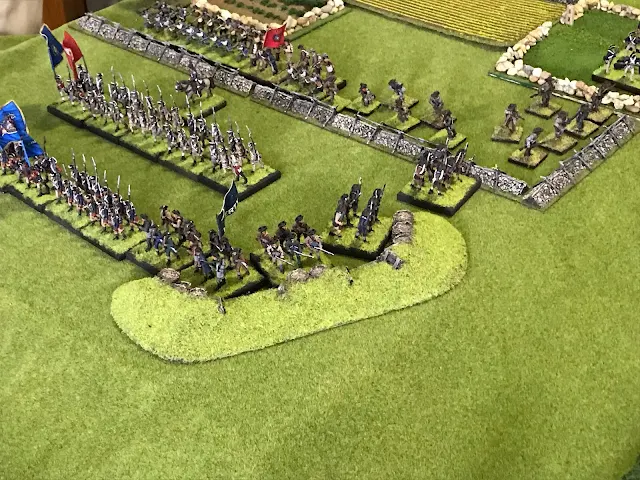Wednesday, November 6, 2019
Getting away
We took a mini vacation to get away from it all this week. Up in the lakes and hills of New Hampshire. Peaceful and relaxing before returning to work and the upturn in work.
Sunday, October 27, 2019
Artillery Bases
Traditionally artillery are on large rectangular bases. This is how everyone else I know has always mounted their artillery stands. It is just the way it was done. A gun, and three to five figures and that is a artillery stand. Add a limber and you are done.
But, on the Fife and Drum miniatures blog I noticed that one player mounted his artillery on a round base. I cannot tell you why, but it looked great. Better then great, I really liked it a lot. So much so that I mounted my War of 1812 artillery on round bases.
Now I am redoing my American Revolution collection. Not a really big deal. Just time consuming. Stay tuned for more pictures when done.
Tuesday, October 22, 2019
Hessian Colors Captured at Trenton. Where Are They?
Rereading Richardson's Standards and Colors of the American Revolution this morning. What happened to the Hessian colors captured at Trenton? They were displayed in the halls of Congress for a short time. On 31 December 1776 William Ellery writes the Governor of Rhode Island a description of the flags which are on display in the room where Congress meets in Baltimore.The six colors captured at Trenton are depicted in good detail in Charles Wilson Peale's painting of Washington victorious after Trenton and Princeton. Other colors captured have survived. There are four Anspach-Beyreuth colors captured at Yorktown still in existence and in good condition. Two are at West Point, one at the Smithsonian and the fourth one at Yorktown. Davis (Regimental colors in the War of the Revolution) said there were no know (to him) Colors in Germany when he did his research during the 1900's. The colors of the 7th (Royal Fusiliers) Regiment are at West Point.
Here is some information about what happened to them. Davis describes the existing colors when he examined them in 1907 in the Historical Society of Pennsylvania and photographed the two flags and the remains of a third which had a black field. These were in the Clymer papers. These two colors and the fragments disappeared sometime between when Davis saw them in 1900-1907 and the mid 1970's when they were found to be missing. It is possible, based on a " cryptic" entry on a accession card that they were loaned out and never returned; possibly during the Sesquicentennial of 1926.
William Buehler wrote Admiral Preble on 18 November 1881 "two flags out of six captured ...At Trenton are in the department on the hill at Harrisburg." This appears to have been the William Penn museum at Harrisburg Pennsylvania. Richardson is quoted as saying staff members " have no knowledge as to the whereabouts of any surviving remnants there. "
Lastly there are fragments of another Hessian flag captured at Trenton in the First City Troop Museum in Philadelphia. The fragments are about " twenty by seven inches and are black brocade will seamed to a narrow strip of White are are decorated with a small elements of brown and yellow painted designs. "
Richardson, Edward W. Standards and Colors of the American Revolution.
1982.
Davis, Gherardi. Regimental Colors in the War of The Revolution.
1907.
For a copy of the book online see:
https://archive.org/details/regimentalcolors00davi/page/n12
Tuesday, October 15, 2019
New Saratoga Book
A great new book about the Saratoga campaign. My friend George just loaned me this. We have a mural fascination with the campaign and have followed the path of Burgoyne's army and walked the battlefields countless times together. He bought it as soon as it came out and dropped it off for me to read after a recent game.
This is a big coffee table book. Don Troiani needs no introduction. The book is filled with both his individual soldier studies and a number of battle paintings. in addition numerous pictures of artifacts (many from his collection) grace the book. You can lose yourself flipping the pages and admiring the art work.
But to me the heart and soul and reason to buy this book is the narrative by Eric Schnitzer. This is first rate and very well done. Saratoga NHP has produced a long line of superb historians of the campaign and battle and Eric is the most recent. His writing reflex an individual who has long studied the campaign; not just the primary sources but has walked the terrain. He is extremely knowledgeable about 18th century military culture and tactics. In addition he has uncovered and used a number of primary accounts I have not seen other authors use. This background has produced one of the very best short accounts of the campaign. My only complaint is I wish for a much longer and more detailed retelling of the campaign and battles. One can only hope this will arrive someday.
I highly recommend this book! I know when I was reading it the other night Janine stole a place at it and saus, "I think I know what to get you for Christmas.". One can only hope .
Wednesday, October 9, 2019
Battle of White Plains 1776
At the end of October 1776 Washington had retreated from Manhattan to Winchester county New York. Taking position at the village of White Plains the Americans dug fortifications. But they left a low series of hills and ridges to their right empty and unoccupied. On the morning of 28 October both sides raced to capture these ridges. The Americans arrived first and started a small entrenchment. The advancing British crossed the Bronx river to attack the Americans while a Hessian Brigade out flanked the position. After causing heavy British casualties the Americans retired off the field.
Because of the interesting troop types and colorful nature of the time of year I thought this would be a wonderful table top battle. In addition the battle holds a warm memory for me as the very first battle reenactment I took part in in October 1972. American Heritage magazine ( in April 1973, volume 24, issue number 3) has a picture of my young self in ranks of my first regiment! Janine volunteered to make lunch for the group of us. A wonderful spaghetti and sausages with salad feast. So now on to the game!
American forces consisted of a brigade of four militia battalions from Connecticut and Massachusetts. General McDougall 's Continental brigade (19th Continental, 1st and 3rd New York Regiments and Smallwood's Marylanders). In addition Haslet's Delaware regiment and Captain Alexander Hamilton's artillery battery arrived to assist. The Americans were to hold the hill as long as possible and cause as many British casualties as possible. The Americans set up using the various walls and fences as cover.
view from the British position towards the American lines.
The British launched a brigade of four battalions across the Bronx river to assault the American position. They were screened by two companies of the loyalist New York Volunteers.
Colonel Rall's brigade outflanks the American position. Here two foxes watch as regiments Knyphausen, Lossburg and Rall advance up the hill. A detachment of Jagers skirmishes ahead of them.
Between the British brigade and Rall the von Bose and 17th Light dragoons advance.
The British command set up on Wolf hill opposite Chatterton hill. A battery of three heavy guns were set up. Although they could not move from that position they did provide support. A battalion of Light Infantry and Grenadiers stood guard as reserves. Lastly Sir William Howe observed the attack (distracted by Mrs Loring). A Shepard and his flock seen unimpressed by the unfolding battle.
The American brigadier moves his battalions up to the crest of the hill. Curiously instead of advancing the rifle armed skirmishers they are kept behind the main line defense.
The American center is held by two Continental regiments and two militia regiments, Hamilton,'s battery and some riflemen.
Taking advantage of the stone walls he positions his battalions. Hamilton's battery takes a position to pound the advancing British in a enclosed field. Lastly, the 19th Continental battalion advanced down hill to annoy the British.
The American left flank is guarded by a small redoubt manned by a militia regiment. A New York continental regiment supported by Smallwood's Maryland Regiment and a militia battalion protect the exposed flank.
The New Yorkers take heavy fire from the three Hessian battalions. They fail their morale test and rout. Smallwood's stands alone against the advancing Germans.
Suffering heavy casualties the Grenadier Regiment Rall fails its morale test and routed back down the hill. The remainder of the brigade continues its advance. The jagers skirmish against the militia in the redoubt. Note the 17th Light Dragoons have flanked the American line!
All of this is too much for the American commanders. The various militia battalions reacting to The routing or retreating units fail their morale and retreat. Wanting to save his Continental battalions he orders a retreat. This ended the game.
All agreed it was a fun scenario and they would like to play it again. I think next time the Americans could be more agressive. Playing it again they could have advanced the rifle armed men to snipe and skirmish with the advancing enemy. This will make the British advance more difficult. I also wonder if the Royal Artillery battery in the hill was too powerful. I might take away one stand of guns in my next try. I will add a few more walls and fences next time and add some fall color trees to get the time of year correct. All in all a successful game that will be fought out again. Thank you to Andy, Jim, Warren and George for attending and playing.
Subscribe to:
Comments (Atom)





































